10.20986/revesppod.2025.1727/2025
ORIGINAL
Determining variables in foot pain in padel players. Observational analysis
Variables determinantes en el dolor podal en jugadores de pádel. Análisis observacional
Juan José Pérez Calonge1
Unai Miqueleiz Erburu2
Roberto Aguado Jiménez3
1Avanza Clínica Podológica. Pamplona, España
2Salud y Rehabilitación. Centro Europeo de Empresas e Innovación de Navarra (CEIN). Pamplona, España.
3Ciencias de la Salud. Universidad Pública de Navarra. Pamplona, España
Abstract
Objective: The objective of this study was to establish the main causes of pain and foot injury during paddle tennis.
Patients and methods: To carry out this work, interviews were conducted with a sample of ninety-six athletes from the main clubs in Navarre who met the inclusion requirements. The variables studied were grouped into anthropometric, morphology of the knee, sports habit, footwear use and complementary.
Results: Players with a height of less than 175 cm, with an overweight body mass index, with specific training and genu valgum, suffered more pain in the last month. Subjects older than 45 years showed a significantly higher onset of pain in the last 3 months. Subjects with an overweight body mass index, with specific training for paddle tennis, genu varum and lumbar pain, showed significantly higher occurrence of injury in the last 3 months.
Conclusion: Reduce the body mass index of paddle players, distribute of the vector forces of the lower limbs, as well as performing a varied training without high specificity, could be the main elements to be considered when preventing the appearance of injury or plantar pain in the practice of paddle tennis, aspects that should be taken into account more with increasing age.
Keywords: Foot, foot injury, paddle tennis, BMI, overweight, foot orthoses
Resumen
Objetivo: El objetivo de este estudio fue establecer las principales causas de aparición de dolor en el miembro inferior en la práctica deportiva del pádel.
Pacientes y métodos: Se diseñó un estudio analítico observacional que se llevó a cabo en los principales clubs deportivos de pádel de Navarra, mediante entrevistas a deportistas que cumplían los requisitos de inclusión. Las variables estudiadas se agruparon en: antropométricas, morfología articular de la rodilla, de hábito deportivo, de uso de calzado y complementarias.
Resultados: Los jugadores con altura inferior a 175 cm, con índice de masa corporal de sobrepeso, con un entrenamiento específico y rodillas valgas, sufrían mayor aparición de dolor en el último mes. Los sujetos con una edad mayor de 45 años mostraban un significativo aumento en la aparición de dolor en los últimos 3 meses. Los sujetos con sobrepeso, con entrenamiento específico para pádel, rodillas varas y dolor lumbar, mostraban significativamente una mayor aparición de lesión en los últimos 3 meses.
Conclusión: Reducir el sobrepeso de los jugadores de pádel, distribuir las fuerzas vectoriales de los miembros inferiores, así como llevar a cabo un entrenamiento variado sin elevada especificidad, podrían ser los principales elementos para tener en cuenta a la hora de prevenir la aparición de lesión o dolor plantar en la práctica del pádel, aspectos que se deben considerar más con el aumento de la edad.
Palabras clave: Pie, dolor, lesión en el pie, pádel, IMC, sobrepeso, ortesis plantares
Corresponding author
Juan José Pérez Calonge
juanjo.podologo@gmail.com
Received: 26-02-2025
Accepted: 13-04-2025
Introduction
Padel(1) is a racket sport played on a court, always in doubles. In 2023, with 98,000 licenses in Spain, it surpassed tennis in popularity. (2,3)Studies indicate that between 34 % and 42 % of injuries occur in the lower limb (LL) versus 25-26 % affecting the upper limb (UL). (4,5,6,7)The foot and ankle are the most affected area, accounting for 41 % of injuries, with plantar fasciitis being the most recurrent. (8) It’s estimated that 2 out of 5 players were injured in 2017, and the probability increases with over 1 year of experience and between 2-6 weekly sessions,9 leading to work absenteeism due to sick leave. (5)
Studies suggest that one of the injury factors could be the artificial turf, a standard surface in padel, (10) and its slippery characteristic, similar to clay in tennis. The inherent nature of the sport—being explosive, fast, and intense with uncontrolled jumps and falls—combined with inadequate technique, could be another factor. The most common movements in padel(11) are lateral displacements, which generate pressure on the mid-forefoot and hindfoot (Figure 1A), and the split-step (jump before hitting the opponent’s shot), where the highest pressures are reached in the forefoot (Figure 1B). To reduce plantar pressure, we should consider two variables: first, the type of court surface. Literature suggests a higher rate of foot and ankle injuries on artificial turf. (12) Since this is a slippery surface, footwear becomes highly relevant, and its choice will be affected by the athletes’ physical condition and sex. (13) In Lam’s study, different heel curvature designs were found in footwear, which could influence the alteration of ground reaction force during impact in badminton lunges and thus affect players’ performance in their vertical load rates and ground reaction forces (GRF) with the potential risk of causing injuries. (14) We haven’t found literature studies analyzing the relationship between footwear, injury location, and type in racket sports, nor studies linking injury rates and sex in padel. However, we did find a study by Yang X et al. (15) where they observed significant differences between men vs women in forward lateral displacement (chasse-step) in hip flexion, adduction, and internal rotation moment in table tennis.
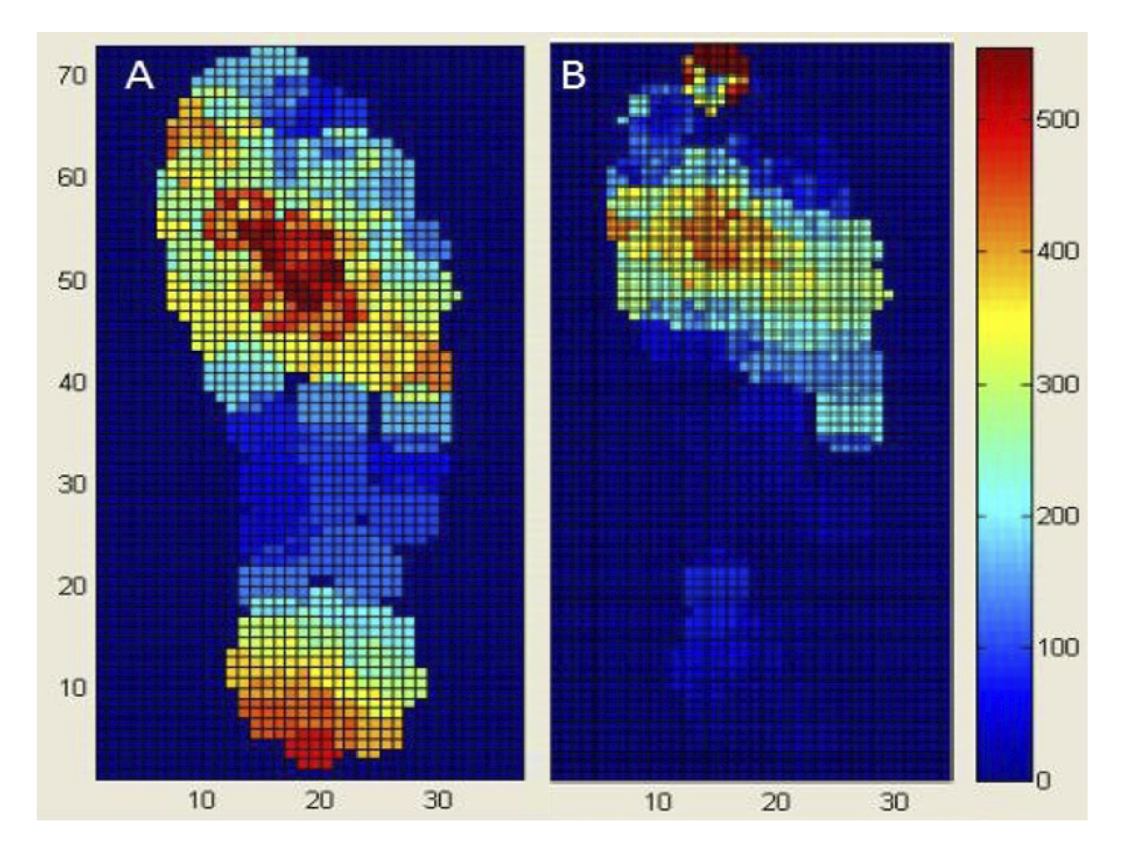
Figure 1. Pressure map during padel gestures (A-forward run, B-split-step). Priego, J.I and collaborators. 2014. Algorithm implemented in MATLAB®.
The number of studies on lower limb injury in padel players is very limited, despite its high practice and current popularity. Similarly, we deem it appropriate to directly transfer the results highlighted in the literature for other racket sports regarding injury-related factors. Therefore, the objective of this study is to determine the influence of various variables analyzed in other racket sport studies on a population of padel players and their impact on the presence of foot pain.
Patients and methods
Study population
The current study was developed from a set of standardized interviews conducted with an adult population of padel players of both sexes. Inclusion criteria: adult padel athletes who trained between 2 and 6 sessions per week, with at least one year of experience, without chronic lower limb injuries (knee ligament ruptures, Achilles tendinopathies, tibia and fibula fractures, among others), and active during the last year. Exclusion criteria were training less than 2 or more than 6 sessions per week, less than one year of padel experience, the presence of chronic lower limb injuries, and not being active during the last year. This was to establish if the occurrence of foot pain or injury during sports practice could be related to anthropometric, age, sex, or footwear use variables, among others.
All data were collected by the main researcher and author of this article (J.J.P.C.). The interviews were conducted in person by the same person, a podiatrist by profession, at clubs in Navarre (Spain) (Pablo Semprun Sport Center, Navarra Pádel, Aranguren Pádel Club). Before any test, the objectives, benefits, and possible risks derived from the studies were explained, and informed consents were signed.
Variables
The analyzed variables were obtained through individual interviews, following a pattern described in a standardized questionnaire for the subject sample (Annex 1).
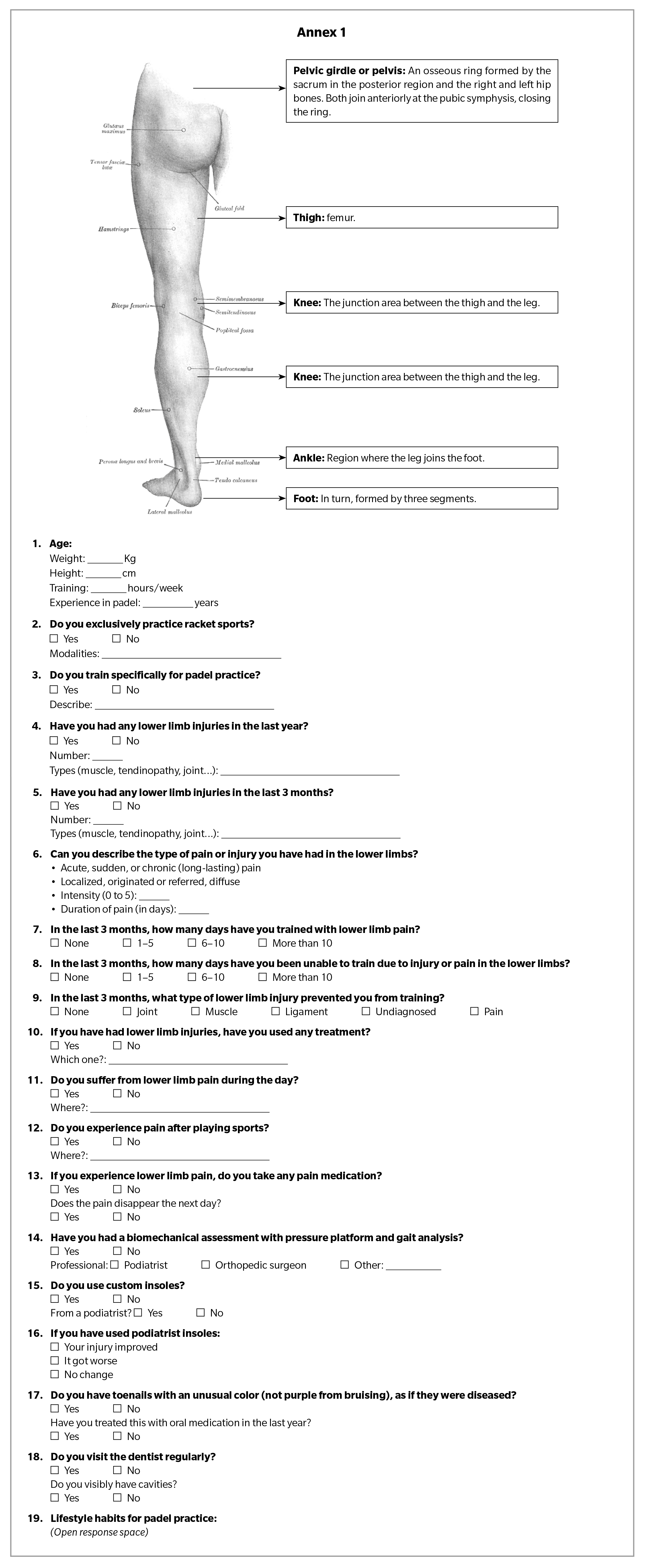
a) Dependent Variables:
- Occurrence of pain during play, not implying cessation of the session. This variable was analyzed for the period of the 3 months prior to the interview, categorized into 3 quantitative categories: Value (0) was defined for subjects who reported no days with pain in the indicated period. Value (1) was defined for subjects who had less than 3 days of pain in the indicated period. Value (2) was defined for subjects who reported more than 3 days of pain in the indicated period.
- Occurrence of injury, linked to a clinical diagnosis or indefinite cessation of play until recovery. This variable was analyzed for the period of the 3 months prior to the interview, classified into 2 values: (0) absence of injury; (1) existence of injury in the indicated period.
b) Independent Variables: Dual variables were studied by dividing the subjects into 2 groups, depending on the presence or absence of the indicated variable (e.g., men and women; normal weight and overweight; with plantar hyperkeratosis and without plantar hyperkeratosis, etc.). For non-dual variables, such as foot size, height, or weight, the group was divided aiming for the greatest equity of the sample in both groups. The subject groupings for each variable are defined in Table 1.
- Anthropometric variables: Sex, weight, height (used to calculate BMI in kg/m2), and foot size were provided by the subjects through the interview.
- Joint morphology variables: Knee alignment in the frontal plane and sagittal axis (straight, varus, or valgus knee) was analyzed visually.
- Sports habit variables: Experience in padel, whether they practiced any other sport or if padel was their exclusive practice, as well as the characteristics of the training performed (whether it was padel-specific or not, or if they were receiving any type of treatment to prevent pain or injury during play) were recorded.
- Footwear use variables: Specific and exclusive use of footwear, duration of use, wear and tear, and use of custom podiatric insoles were analyzed.
- Complementary variables: The occurrence of onychomycosis and plantar hyperkeratosis that could affect foot support was analyzed through a visual clinical examination performed on all participants to observe foot lesions, as well as lower back pain or quality of night rest.
Statistical analysis
Mean and standard deviation were used for quantitative variables, and percentages for qualitative variables. The studied sample was grouped into two general morphological median groups with different numbers of subjects for each variable, as already indicated. A hypothesis test was applied to evaluate the difference in means between the resulting study groups for each dependent variable using the unpaired t-student test (independent samples) to determine if there was a significant difference between the means of the two groups. The significance level was set at p < 0.05. The dependent variables studied were: pain, injury in the last month period, and injury in the last 3 months. Before performing the test, data normality was verified using the Shapiro-Wilk test, and homogeneity of variances was evaluated with Levene’s test. The results showed that the data met the necessary assumptions for applying the t-student test. The results indicated whether the means of each group, presented as average and standard deviation (SD), were significantly different from each other. This suggests that the variable differentiating each group had a positive effect on the presence of pain or injury in the subjects.
Results
The sample resulted in 96 subjects who fully completed the study and interview. The subjects in the sample were divided into 2 groups according to anthropometric, conditional, implement, and morphological variables, as shown in Table 1.
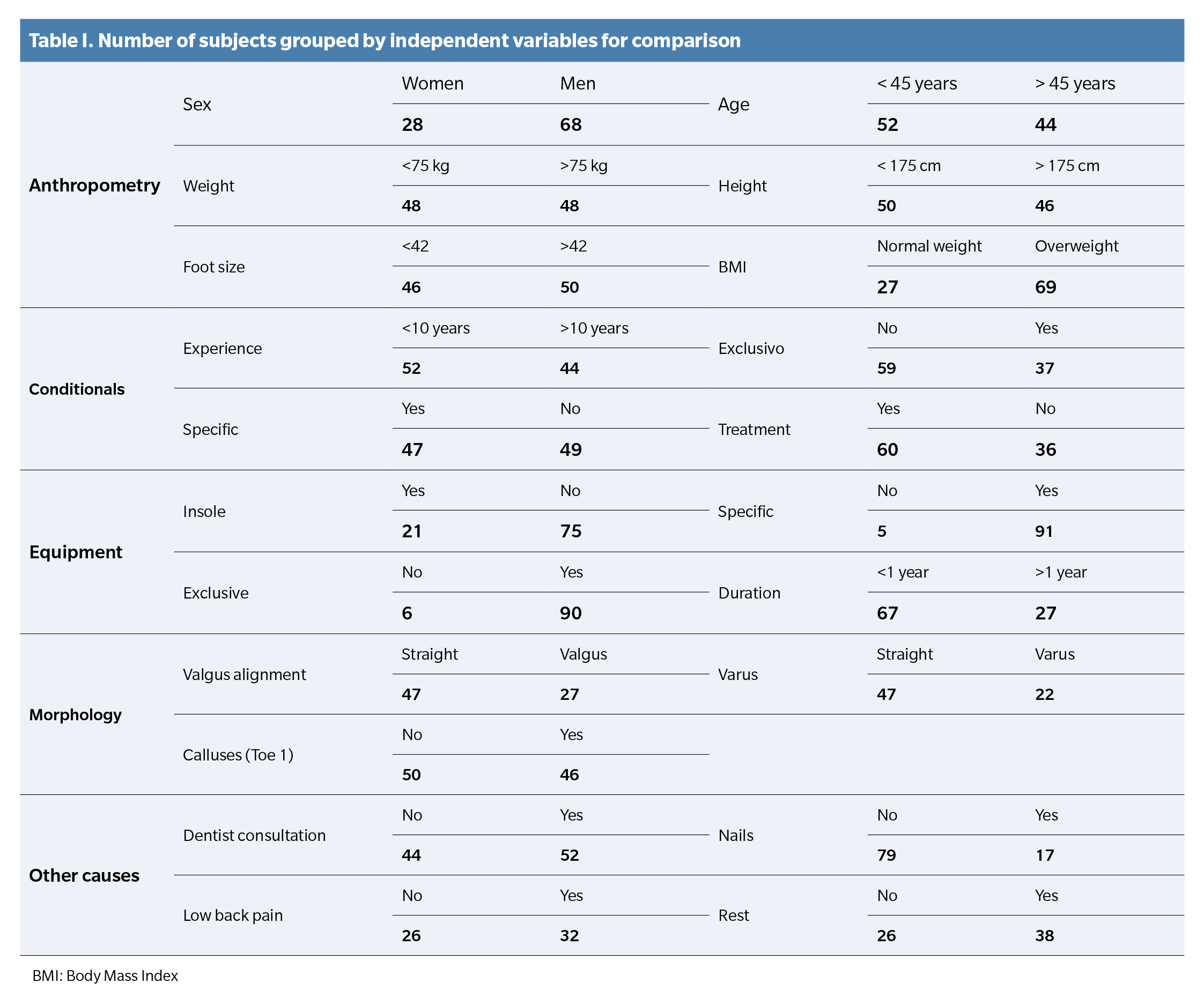
Regarding the Pain variable in the last month variable, the complete group of subjects showed a mean of 0.49 ± 0.97 on the previously defined scale. The independent variables of height, BMI, pain treatment, training specificity, knee curvature, and lower back pain showed statistically significant differences in the studied groups regarding pain in the last month (Table 2). The group with greater height, overweight, without pain treatment, with specific training, with valgus knees, and with lower back pain were associated with pain in the last month. No statistically significant differences were found for the variables sex, padel experience, exclusively padel, onychomycosis, dental check-ups, use of custom podiatric insoles, exclusive and specific padel footwear, type of warm-up, hyperkeratosis, weekly sessions, post-training stretches, and footwear wear location with pain in the last month.
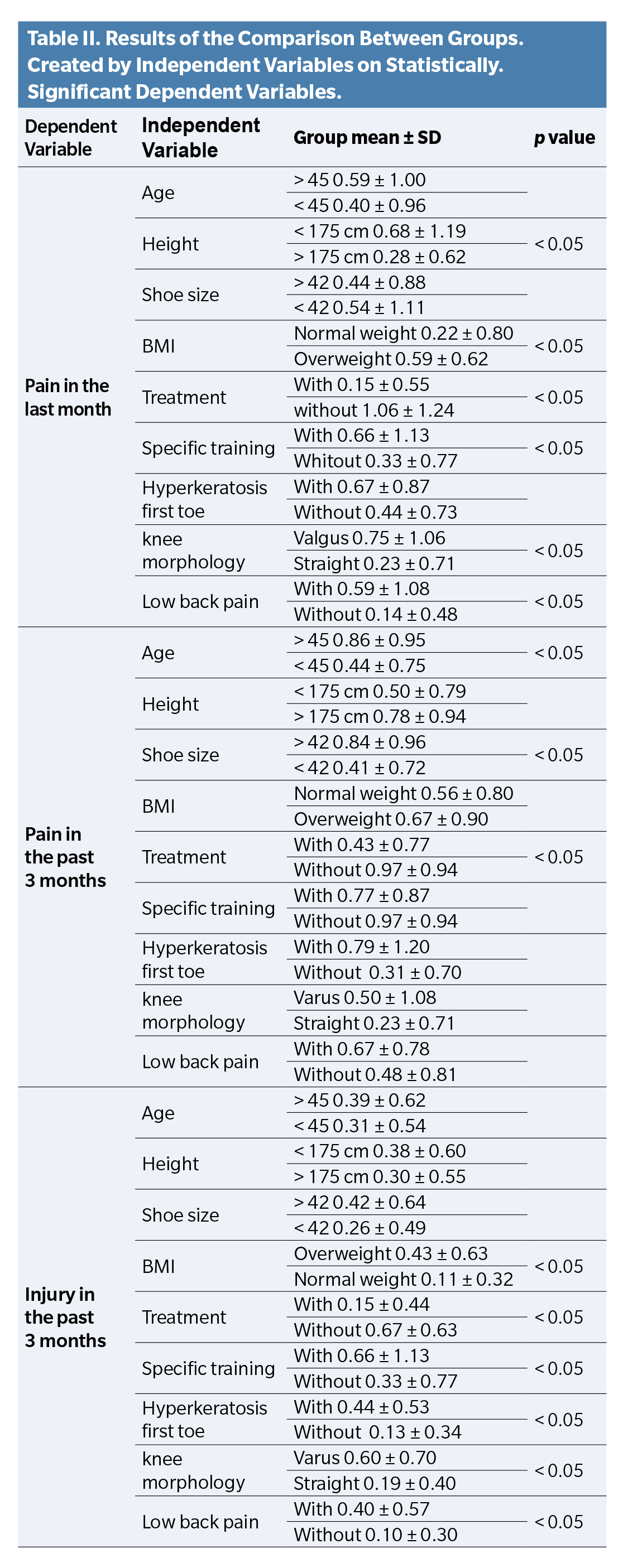
Regarding the Pain variable in the past 3 months variable, the complete group of subjects showed an average pain of 0.64 ± 0.87 on the previously defined scale. The independent variables of Age, footwear size, and pain treatment showed statistically significant differences in the studied groups regarding pain in the last 3 months (Table II). Those older than 45 years, with footwear size > 42, and undergoing treatment were associated with pain in the last 3 months. No statistically significant differences were found for the variables height, BMI, sex, specific training, knee morphology, lower back pain, padel experience, exclusively padel, onychomycosis, dental check-ups, use of custom podiatric insoles, exclusive and specific padel footwear, type of warm-up, hyperkeratosis, weekly sessions, post-training stretches, and footwear wear location with pain in the last 3 months.
Regarding the Injury variable in the last three months variable, the complete group of subjects showed a mean 0.34 ± 0.58 on the previously defined scale. The independent variables of BMI, pain treatment, training specificity, plantar hyperkeratosis, knee curvature, and lower back pain showed statistically significant differences in the studied groups regarding injury in the last 3 months (Table 2). Those who were overweight, without treatment or specific training, with plantar hyperkeratosis on the 1st toe, with valgus knees, and with lower back pain were associated with injury in the last three months. No statistically significant differences were found for the variables height, age, sex, padel experience, exclusively padel, onychomycosis, dental check-ups, use of custom podiatric insoles, exclusive and specific padel footwear, type of warm-up, weekly sessions, post-training stretches, and footwear wear location with injury in the last three months.
Discussion
The current study analyzed variables related to the presence of lower limb pain in padel athletes. This is one of the first specific studies to evaluate various anthropometric, sport-related, complementary, etc., variables with the presence of lower limb pain. Girad et al. in 20010 (Figure 2) analyzed typical tennis strokes on 2 types of surfaces: clay and hard court, observing that on slippery courts, contact time is longer, contrary to friction, which was greater on hard court. One could speculate that the friction/pressure properties of the tennis shoe sole and the type of surface are a variable directly related to the frequency and severity of pain/injuries. These pressures on the feet due to unilateral movement and inappropriate footwear can generate plantar hyperkeratosis16 causing pain, as well as onychomycosis due to trauma.17 In recent years, 97.4 % of players use specific padel shoes, with the herringbone sole being the most common (70 %).18 Functional insoles with arch support can reduce impact and prevent lower limb injuries,19 as in other sports.20-22 It should be noted that some of the studied variables are not modifiable and would serve to establish a greater or lesser probability of suffering pain or injury during padel play, while others could be corrected and, therefore, reduce the probability of causing pain or injury.
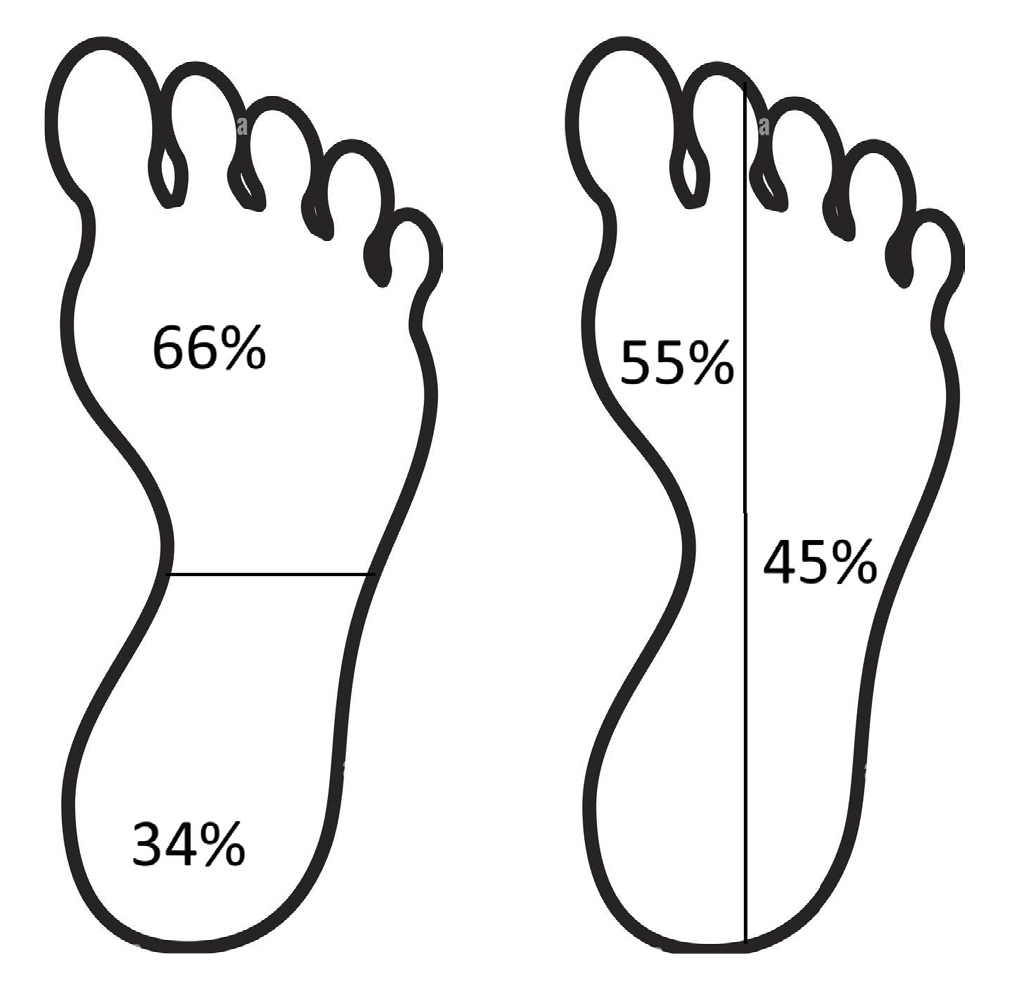
Figure 2. Mean relative load for each foot region during a tennis volley. Girad O. and collaborators in 2007. Forefoot 66 %, hindfoot 34 %, medial zone 55 %, and lateral 45 %.
Therefore, the results are approached from the perspective of clinical intervention, observing in this regard that subjects with a BMI > 24.9 lead to a greater occurrence of foot pain and injury, perhaps because they generate greater acceleration and braking forces during movements in the game. Thus, García Vidal et al. in 2019(23) state that an increase in BMI has a significant effect on the level of pain and functional limitation in patients with plantar fasciitis. This argument seems consistent with the works of Majumdar and Robergs in 2011 where they state that high BMI is related to higher speed and consequently to an increase in braking force. (24)
Regarding the morphology of alignment in the knee joint and its vectorial forces, it seems that the presence of knee curvature in the frontal plane could be related to the presence of generalized foot pain and injury during padel play, an argument supported by Ke Li et al. in their 2023 work, stating that knee alignment affects plantar pressure, and thereby pain. (25) Therefore, the loss of linearity in the knee joint seems to be one of the causes that lead to modification of foot support during play, knowing that unbalanced plantar support could be responsible for the appearance of hyperkeratosis, these being a good reference for predicting the appearance of injuries. This argument seems consistent with the works of Tong-Hsien Chow et al. in 2021, who demonstrate the relationship between tissue tension in unbalanced support, with the appearance of hyperkeratosis and the development of plantar injuries. (26) Of note, in this regard, that this deviation from the linearity of the knee joint and consequently its vectorial forces could be compensated by podiatric plantar support techniques, such as the use of custom podiatric insoles in footwear.
Similarly, as observed, foot pain could be related to lower back pain, presumably due to a lower capacity for impact absorption during movements. It is possible that these causes of pain and injury could be reduced through the use of insoles, since, as observed, the use of functional insoles with custom internal longitudinal arch support are more effective in decelerating impact against the ground than prefabricated ones, preventing pain and lower limb injury and increasing their stability, (21) aspects observed in other sports, where insoles are also effective in reducing lower limb injuries, (21,22)or compensating for excessive subtalar pronation, which is related to a varus forefoot, an insufficient first ray, or an internal rotatory gait. (27)
In any case, in addition to observing that a correction of the above variables through podiatric techniques could prevent the appearance of foot pain or injury, these could be complemented with varied training avoiding high specificity to the sport of padel, which seems to increase the probability of plantar pain during play. On the other hand, after analyzing the results, it is observed that the risk of suffering foot pain or injury associated with the athlete’s morphology seems to increase with increasing age. This higher incidence rate could be due to a decrease in collagen production and a decrease in the regenerative capacity of connective tissues. (28,29)
Although there are no studies that establish a direct relationship between stature and foot injury or pain, certain sports disciplines, such as basketball, present specific injury patterns due to the characteristics of the sport and the biomechanics involved. The data recorded in this study show that greater height is related to a lower incidence of pain and injury, which could be because this characteristic allows the player to cover a larger area on the playing field, so shorter subjects, and therefore with less ability to cover the playing space, must perform more movements and therefore more plantar effort that could be the cause of the observed pain.
It should be noted that the rest of the complementary variables analyzed, such as the appearance of onychomycosis, do not show statistical differences, which could be because the participant population in this study is not large enough, since studies such as those by Julianne, M et al. in 2022 show that unguinal malformations due to onychomycosis are a cause of pain. (30)
Nor is a relationship found between foot pain or injury and the appearance of hyperkeratosis, despite its high prevalence, reaching 59 % of subjects, as shown by studies by Zambrano et al. in 2023, when addressing the epidemiology of podiatric injuries in athletes. (31)
The present study has several limitations, meaning its results should be taken with some caution. The main one refers to the methodological difficulties inherent in the study design using interviews. The dependence on the responses of the participating subjects in the study, and thereby the possible link to the subjects’ memory in recording foot pain or injury variables, could have affected the results obtained. Another limitation is the absence of studies in the sport of padel, which makes it difficult to compare statistical data, as well as the individuality with which participants tolerate pain as something habitual, which refers to the great difference in manifesting it in people who live with pain and those for whom pain is of late onset.
Finally, it might be advisable to establish new longitudinal studies in which some of the variables related to plantar pain can be modified, such as BMI, the vectorial forces influencing the knee through the use of custom podiatric insoles that in turn help decelerate impacts in the sport, which would allow us to analyze injurious data in amateur padel.
In conclusion, the data obtained in the present study suggest that reducing the BMI of padel players and compensating for lower limb vectorial forces, as well as implementing varied training without high specificity, could be factors to consider when preventing the appearance of plantar injury or pain in padel practice, aspects that should be taken more into account with increasing age.
Ethical Declaration
The study was approved by the Ethics Committee for Animal Experimentation and Biosafety of Universidad Pública de Navarra (PI/07-02-19) in full compliance with the Declaration of Helsinki.
Conflicts of interest
All authors declare that they have no financial or other relationship that could lead to a conflict of interest related to this work. Nor are there any conflicts of interest between any of the authors of this article.
Data and materials availability
The dataset used and/or analyzed during the current study is available from the corresponding author upon reasonable request.
Funding
None declared.
Authors’ contributions
Study conception and design: JJPC, RAJ.
Data collection: JJPC.
Analysis and interpretation of results: JJPC, RAJ, UME.
Creation, drafting, and initial draft preparation: JJPC. Final review: JJPC, RAJ.
Supplementary data
Annex 1 includes all variables collected during the interviews used.
References
- ASALE: Real Academia Española y asociación de Academias de la Lengua Española [acceso Jun 2021]. Disponible en: https://www.rae.es/dpd/pádel
- CSD: Consejo Superior de Deportes. Federaciones Deportivas Españolas-Licencias [acceso Jun 2021]. Disponible en: https://www.csd.gob.es/es/federaciones-y-asociaciones/federaciones-deportivas-espanolas/licencias
- Courel Ibáñez J, Sánchez-Alacaraz Martínez BJ, García Benítez S, Echegaray M. Evolution of padel in Spain according to practitioners’ gender and age. CCD. 2017;12(34):39-46. DOI: 10.12800/ccd.v12i34.830.
- Changstrom B, McBride A, Khodaee M. Epidemiology of racket and paddle sports-related injuries treated in the United States emergency. J Phys Sportsmed. 2022;50(3):197-204. DOI: 10.1080/00913847.2021.1892467.
- Gaw CE, Chounthirath T, Smith GA. Tennis-related injuries treated in United States emergency departments. Clin J Sport Med. 2014;24(3):226-32. DOI: 10.1097/JSM.0000000000000029.
- Tagliafico AS, Torri L, Righetto R. Injuries in non-professional padel tennis players Results of a survey of the Italian Federation of Tennis in Liguria, Italy. J Sports Med Phys Fitness. 2023; 63(4):566-56. DOI: 10.23736/S0022-4707.22.14280-5.
- Sánchez Alcaraz-Martínez BJ, Courel-Ibáñez J, Díaz García J, Muñoz Marín D. Estudio descriptivo de lesiones de pádel: relación con el género, edad, nivel de los jugadores y localización de las lesiones. Rev Andal Med Dep. 2019;12(1):29-34. DOI: 10.33155/j.ramd.2018.02.004.
- García-Fernández P, Guodermar Pérez J, Ruiz López M, Rodriguez López ES, García Heras A, Hervás Pérez JP. Epidemiology of injuries in professional and amateur Spanish paddle players. Rev Int Med Cienc Acti Fís Dep. 2019;19(76):641-54. DOI: 10.15366/rimcafd2019.76.006.
- Priego Quesada J, Sanchís Almenara M, Kerr ZY, Alcantara E. Examination of the risk factors associated with injured recreational padel players in Spain. J Sport Med Phys Fitness. 2018;58(1-2):98-105. DOI: 10.23736/S0022-4707.16.06729-3.
10. Girard O, Eicher F, Fourchet F, Micallef JP, Millet GP. Effects of the playing surface on plantar pressures and potential injuries in tennis. Br J Sports Med. 2007; 41(11):733-8. DOI: 10.1136/bjsm.2007.036707.
- Priego Quesada J, Olaso J, Llana Belloch S, Pérez Soriano P, González JC, Sanchis M. Estudio presurométrico y biomecánico del pie en el pádel. RICCAFD. 2014;1(1):21-26. DOI: 10.24310/riccafd.2014.v3i1.6191.
- Xiao M, Lemos JL, Hwang CE, Sherman SL, Safran MR, Abrams GD. Increased risk of ACL injury for female but not male soccer players on artificial turf versus natural grass: A systematic review and meta-analysis. Orthop J Sports Med. 2022;12;10(8). DOI: 10.1177/23259671221114353.
- Kong PW, Bagdon M. Shoe preference based on subjective comfort for walking and running. J Am Podiatr Med Assoc. 2010;100(6):456-62. DOI: 10.7547/1000456.
- Lam WK, Ryue J, Lee KK, Park SK, Cheung JT, Ryu J. Does shoe heel design influence ground reaction forces and knee moments during maximum lunges in elite and intermediate badminton players? Plos One. 2017;12(3):e0174604. DOI: 10.1371/journal.pone.0174604.
- Yang X, Mei Q, Shao S, Gu W, He Y, Zhu R, et al. Understanding sex-based kinematic and kinetic differences of chasse-step in elite table tennis athletes. Bioengineering (Basel). 2022;4;9(6):246. DOI: 10.3390/bioengineering9060246.
- Prats Climenta B. Alteración local de las partes blandas. Rev Esp Reumatol. 2003;30(9):503-07.
- Elewski BE. Onychomycosis: Pathogenesis, diagnosis, and management. Clin Microbiol Rev. 1998;11(3):415-29. DOI: 10.1128/CMR.11.3.415.
- Demeco A, de Sire A, Marotta N, Spano R, Lippi L, Palumbo A, et al. Match analysis, physical training, risk of injury and rehabilitation in padel: Overview of the literature. Int J Environ Res Public Health. 2022;31;19(7):4153. DOI: 10.3390/ijerph19074153.
- Huang SK, Chen ZR, Peng ST, Li SY, Peng HT. The influence of the functional insole with arch support on pitching performance of baseball pitchers. Sports Coach Sci. 2016; 44:39-46. DOI: 10.6194/SCS.2016.44.05/.
- Chen ZR, Chen YR, Cheng HY, Song CY, Chen YH, Peng HT. Effect of arch support insole on lower extremity loading and kinematics during the rebound. J Phys Educ Sports Sci. 2016; 22:33-42. DOI: 10.6634/2fJPSS-CCU.201606.22.04.
- Su CH, Tai WH, Peng HT. Effects of arch support insoles on tennis strokes. J Sports Perform. 2016;3:41-8. DOI: 10.3966/240996512016060301007.
- Chen HW, Chen SY, Kim K, Peng HT. Effect of arch support insoles on the sport biomechanical parameters of Pétanque players when shooting. Int J Environ Res Public Health. 2022;7;19(18):11210. DOI: 10.3390/ijerph191811210.
- García Vidal JA, Baño Alcaraz A, Sánchez Martínez P, Pascual Gutiérrez R, Sánchez Marín S. Correlación entre los valores del índice de masa corporal y las subescalas del Manchester Foot Pain and Disability Index en pacientes con fascitis plantar. J Eur Podiatr. 2019;5(1):1-6. DOI: 10.17979/ejpod.2019.5.1.3746.
- Majumdar AS, Robergs, R. The science of speed: Determinants of performance. In the 100 m sprint. Int J Sports Sci Coach. 2011;6(3):479-93. DOI: 10.1260/1747-9541.6.3.479.
- Li K, Sun FL, Guo HB, Shi ZJ, Yao R, Zhang H. Comparison of the plantar pressure distribution and mechanical alignment in patients with varus knee osteoarthritis following high tibial osteotomy. BMC Musculoskelet Disord. 2023;13;24(1):479. DOI: 10.1186/s12891-023-06603-7.
- Chow TS, Chen YS, Hsu CC. Relationships between plantar pressure distribution and rearfoot alignment in the Taiwanese college athletes with plantar fasciopathy during static standing and walking. Int J Environ Res Public Health. 2021;18(24):12942. DOI: 10.3390/ijerph182412942.
- Marwaha RK, Ranade AR, Sahasrabudhe AV, Jaiswal P, Rairikar S, Sancheti P. Correlation between patellofemoral pain and foot posture. Indian J Physiother Occup Ther. 2015;9(1):99-102. DOI:10.5958/0973-5674.2015.00021.0
- Dressler P, Gehrin D, Zdzieblik D, Oesser S, Gollhofer A, Köning D. Improvement of functional ankle properties following supplementation with specific collagen peptides in athletes with chronic ankle instability. J Sport Sci Med. 2018;17(2):298-304.
- Chan JJ, Chen KK, Sarker S, Hasija R, Huang HH, Guzman JZ, et al. Epidemiology of Achilles tendon injuries in collegiate level athletes in the United States. Int Orthop. 2020;44(3):585-94. DOI: 10.1007/s00264-019-04471-2.
- Falotico JM, Lipner SR. Updated perspectives on the diagnosis and management of onychomycosis. Clin Cosmet Investig Dermatol. 2022;15:1933-57. DOI: 10.2147/CCID.S362635.
- Zambrano C, Pérez Pico AM, Villar Rodríguez J, López Ripado O, Mayordomo Acevedo R. Lesiones de interés podológico en la práctica habitual de deportes de contacto. Rev Esp Pod. 2023;34(2):104-8. DOI: 10.20986/revesppod.2023.1668/2023.